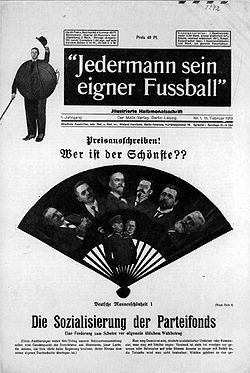
Jedermann sein eigner Fussball
Encyclopedia

Wieland Herzfelde
Wieland Herzfelde was a German publisher and writer. He is particularly known for his links with German avant-garde art and Marxist thought, and was the brother of the photo montage artist John Heartfield, with whom he often worked.-Life:His parents were Franz Held, a writer, and Alice Stolzenberg...
's publishing house). The satirical periodical in tabloid format was published on February 15, 1919, and confiscated immediately on publication by the police. It includes two photomontages by John Heartfield
John Heartfield
John Heartfield is the anglicized name of the German photomontage artist Helmut Herzfeld...
on the front cover and six line drawings by George Grosz
George Grosz
Georg Ehrenfried Groß was a German artist known especially for his savagely caricatural drawings of Berlin life in the 1920s...
. Texts by Herzfelde, Walter Mehring
Walter Mehring
Walter Mehring was a German author and one of the most prominent satirical authors in the Weimar Republic. He was banned during the Third Reich, and fled the country.-Biographical:...
, Mynona; other contributors jointly credited include Richard Huelsenbeck
Richard Huelsenbeck
Richard Huelsenbeck was a poet, writer and drummer born in Frankenau, Hessen-Nassau.Carl Wilhelm Richard Hülsenbeck was a medical student on the eve of World War I. He was invalided out of the army and emigrated to Zürich, Switzerland in February 1916, where he fell in with the Cabaret Voltaire...
, Erwin Piscator
Erwin Piscator
Erwin Friedrich Maximilian Piscator was a German theatre director and producer and, with Bertolt Brecht, the foremost exponent of epic theatre, a form that emphasizes the socio-political content of drama, rather than its emotional manipulation of the audience or on the production's formal...
, Karl Nierendorf, and J.H. Kuhlemann. The cover's typeface and layout used satirise contemporary trends in conservative German newspaper design.
The issue contains photomontages such as Heartfield’s "Wer ist der Schönste? (who is the most beautiful?)," a proposed beauty contest of government leaders whose faces are playfully spread across an open fan. In spite of its absurdist amusements, this singular issue was a work of impassioned radical opinion, published only a few weeks after the communist revolt in Berlin
Berlin
Berlin is the capital city of Germany and is one of the 16 states of Germany. With a population of 3.45 million people, Berlin is Germany's largest city. It is the second most populous city proper and the seventh most populous urban area in the European Union...
had been quashed by Gustav Noske
Gustav Noske
Gustav Noske was a German politician of the Social Democratic Party of Germany . He served as the first Minister of Defence of Germany between 1919 and 1920.-Biography:...
's Free Corps
Freikorps
Freikorps are German volunteer military or paramilitary units. The term was originally applied to voluntary armies formed in German lands from the middle of the 18th century onwards. Between World War I and World War II the term was also used for the paramilitary organizations that arose during...
, and Karl Liebknecht
Karl Liebknecht
was a German socialist and a co-founder with Rosa Luxemburg of the Spartacist League and the Communist Party of Germany. He is best known for his opposition to World War I in the Reichstag and his role in the Spartacist uprising of 1919...
and Rosa Luxemburg
Rosa Luxemburg
Rosa Luxemburg was a Marxist theorist, philosopher, economist and activist of Polish Jewish descent who became a naturalized German citizen...
murdered. "Jedermann sein eigner Fussball" is an example of Berlin Dada
Dada
Dada or Dadaism is a cultural movement that began in Zurich, Switzerland, during World War I and peaked from 1916 to 1922. The movement primarily involved visual arts, literature—poetry, art manifestoes, art theory—theatre, and graphic design, and concentrated its anti-war politics through a...
in its most aggravated political phase.
Sources
related:

